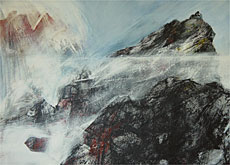
Paintings unleash primeval mountain forces

The quote by the 19th century British critic, John Ruskin, that “mountains are the beginning and end of all natural scenery,” neatly sums up an art exhibition at the Chablais museum in Bex.
Through the paintings of Swiss-Australian artist Lucienne Fontannaz the viewer is invited to experience the Alps at close range.
Each painting is accompanied by the writings of an 18th or 19th century poet or thinker, who were themselves awestruck by their first encounter with the Alps.
The British poet, Lord Byron, wrote in his epic work “Childe Harold”:
“The avalanche – the thunderbolt of snow!
All which expands the spirit, yet appals…
In Fontannaz’s hands, the mountains are living creatures and woe betide the person who dares climb atop their rocky ledges or icy flanks to try to understand their primeval energy.
Jagged peaks
In some of her canvasses, you sense that the thin white streaks are the mountain’s cold breath, blowing harshly when the giant is troubled, swirling dementedly round dark, jagged peaks.
The winds are capable of sweeping you from the mountainside, or blowing you down into fiery red crevasses leading into the deepest recesses of the earth.
“Victor Hugo said it was impossible to paint mountains because they were so beautiful and horrible at the same time,” Fontannaz told swissinfo.
“The horizon is impossible in a [mountain] landscape and the perspective unbelievable. It’s like a chaos of exaggeration and it can be frightening.”
Fontannaz’ mountains bear no resemblance to the photographic images of the Alps printed on the calendars she used to receive in Australia from Swiss friends and relatives.
“They were full of pictures of beautiful mountains on the horizon, beautiful blue skies above – and snow,” remembers Fontannaz.
Childhood inspiration
“But strangely enough that’s not at all how I saw them. I was born in Bex at the foot of the mountains, and they are still part of me.
“And that really was the main inspiration to start painting mountains, to try to express that particular feeling of being so close that you are part of them.”
Working from her Sydney studio overlooking the Pacific Ocean, Fontannaz wanted to create the images conjured up by the writings of early alpine explorers like Hugo, Byron and the 18th century scientist, Horace Bénédict de Saussure.
But she found as much inspiration in her own youthful memories.
Mountain echo
“The texts that I chose sort of echo my own memories, but at the same time give me an indication of the range of feelings one can have when seeing the mountains for the first time,” Fontannaz says.
She uses the example of de Saussure who, when looking at the Alps, declared he was witnessing the origins of the world.
He claimed the mountains were formed below the sea and were then pulled up by the mighty force of the earth’s inner fire.
“The writings made me rediscover feelings, strengthening them and the effect of surprise, admiration and terror,” Fontannaz said.
Complimenting the historical aspect of the works is a slideshow illustrating how mountains have been depicted in works of art over the centuries, from ancient Greece to the 1900s.
Interactive displays are spread throughout the exhibition space, highlighting mountain legends from the Chablais region and the many famous travellers who once stopped here during their alpine journeys.
swissinfo, Dale Bechtel in Bex
The exhibition “L’Alpe fantasmée”, runs until September 26 in the Chablais history museum, located in Bex in western Switzerland.
At the centre of the exhibition are more than 100 paintings by Swiss-Australian artist Lucienne Fontannaz.
Her paintings were inspired by her childhood memories of growing up in the Alps and texts by 18th and 19th century writers.
Key sources were Horace Bénédict de Saussure’s “Travels in the Alps”, Lord Byron’s “Childe Harold” and John Ruskin’s “Modern Painters”.
Knowledge of French is necessary to understand the historic texts accompanying the paintings and displays.
Bex is also home to an old salt mine, which has been turned into Switzerland’s most important museum of its kind.

In compliance with the JTI standards
More: SWI swissinfo.ch certified by the Journalism Trust Initiative
































You can find an overview of ongoing debates with our journalists here . Please join us!
If you want to start a conversation about a topic raised in this article or want to report factual errors, email us at english@swissinfo.ch.